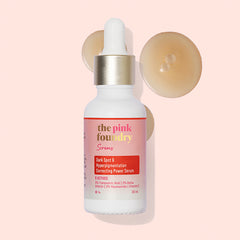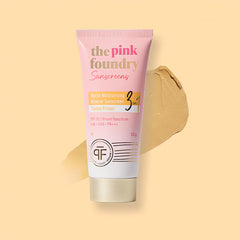Niacinamide 5% vs 10%: How to Pick The Right One for You
- Niacinamide: What Is It and How Does It Work?
- Niacinamide 5% vs 10%: Key Differences
- What Does Niacinamide 5% Do for Your Skin?
- What Does Niacinamide 10% Do for Your Skin?
- Is 5% Niacinamide Better Than 10%?
- How to Choose Between 5% and 10% Niacinamide for Your Skin
- When to Use Niacinamide 5% or 10% in Your Skincare Routine
- Conclusion
- Frequently Asked Questions
Niacinamide, or vitamin B3, has become popular in skincare products. It offers a wide range of benefits for all skin types. It is most popularly used to minimise pores, improve texture, regulate oil production, fade dark spots, and reduce fine lines and wrinkles.
With its rising popularity, you may have noticed an increasing number of skincare products featuring different percentages of niacinamide. This leaves many wondering: 5% vs 10% niacinamide? Which one is better? etc.
This article offers an in-depth look at the key aspects of 5% niacinamide vs 10% niacinamide to help determine which strength is right for your unique skin needs.
Niacinamide: What Is It and How Does It Work?
Niacinamide is a water-soluble form of vitamin B3. Unlike many skincare ingredients that sit on the skin's surface, niacinamide penetrates deeply into skin layers, where it gets straight to work.
Once absorbed, niacinamide provides skin cells energy and nutrients to stimulate cell communication and growth. It also regulates oil and sebum production, reduces inflammation, improves ceramide levels to reinforce the skin barrier, and brightens the skin by inhibiting pigment transfer.
With all these incredible benefits, it is no wonder that niacinamide has become such a popular must-have ingredient in skincare products. The Pink Foundry's Super Clarifying Niacinamide Face Serum for All Skin Types can be perfect for blemish-free, healthy skin.
Niacinamide 5% vs 10%: Key Differences
This section explores the key differences between 5% and 10% Niacinamide. Notable differences between the two most popular niacinamide concentrations include the following:
Strength and concentration
As the percentages suggest, 10% niacinamide contains a higher concentration and strength than 5%. With twice the concentration of their 5% counterparts, 10% niacinamide products offer enhanced delivery of nutrients to skin cells. This often leads to amplified results, especially when minimising pores, evening skin texture, fading hyperpigmentation, and smoothing fine lines.
How do different percentages affect results and skin tolerance?
A higher 10% niacinamide concentration means the ingredients get absorbed deeper and faster. This can translate to quicker visible results for people with extremely resilient skin.
However, a concentration of too high niacinamide can cause adverse reactions like redness, dryness, and breakouts for sensitive or acne-prone skin types. This is because skin care products containing higher strengths of niacinamide can penetrate rapidly into skin layers, which can be overstimulating.
Conversely, the lower 5% concentration offers a more gradual release of nutrients to skin cells. This makes it ideal for those just starting with niacinamide, as it allows the skin to adjust slowly. The 5% dosage is also better tolerated by people with sensitive or reactive skin.
What Does Niacinamide 5% Do for Your Skin?
Skincare products containing 5% niacinamide offer skin-enhancing benefits at a beginner-friendly concentration that is gentle enough for all skin types. Using a lower concentration can have several benefits depending on skin type. Some of the highlightable benefits one can expect from regularly using a skincare product with 5% niacinamide include the following:
- Minimised appearance of pores
- More even, smooth skin texture
- Regulated oil and sebum production
- Fading of minor pigmentation and discoloration
- Strengthened moisture barrier function
- Calming of inflammation and redness
The 5% concentration delivers enough niacinamide to reveal brighter, balanced skin. Research shows that concentrations as low as 2% niacinamide can still result in incredible improvements. Let us further explore the benefits of using 5% niacinamide in detail:
- Gentle for sensitive skin: The slower release of nutrients from 5% niacinamide makes it ideal for people with sensitive or reactive skin. The lower dosage concentration can help avoid irritation, dryness, and breakouts.
- Gradual improvement: While the 5% concentration brings noticeable yet subtle changes, upgrading to 10% niacinamide can be an option once the skin builds tolerance. This gradual approach allows the skin to adjust slowly as one works up to higher percentages.
What Does Niacinamide 10% Do for Your Skin?
If one finds that their skin can tolerate and handle the stronger concentrations of niacinamide, they will likely experience enhanced skincare effects. This section explores some of them in detail:
- Enhanced efficacy: With double the concentration of 5%, the 10% niacinamide packs more potency. One can experience a surge of nutrients delivered to skin cells, highlighting niacinamide's rejuvenating benefits.
- More noticeable effects: Not only does the 10% concentration offer quicker results, but these results are often more pronounced. Improvements to skin texture, tone, pigmentation, fine lines, and breakouts usually stand out more clearly with 10% niacinamide.
- Particularly beneficial for acne marks, pigmentation, and fine lines: People struggling with stubborn hyperpigmentation, scarring, or more prominent wrinkling tend to see dramatic improvements with 10% niacinamide versus lower percentages. So, 10% niacinamide can have fast-acting, enhanced effects for people who can tolerate higher strengths.
Is 5% Niacinamide Better Than 10%?
Sometimes, less is more in terms of skincare products. While 10% niacinamide has more potency, the lower 5% concentration also offers unique advantages.
Pros of using lower concentrations
There can be several benefits of using lower concentrations. Some of the highlightable pros include the following:
- It is ideal for skincare newbies and people with sensitive skin types
- Lower risk of irritation or reactions
- Gradual acclimatisation and cumulative effects
- Often featured in budget-friendly formulas.
When a higher percentage may be more beneficial
The benefits of using skincare products containing higher percentages of niacinamide include the following:
- Targeting moderate to severe pigmentation
- Addressing deep wrinkles and fine lines
- Clearing up moderate to severe acne
- Beneficial for people with extremely resilient skin
Whether 5% or 10% niacinamide is “better” depends entirely on one's unique skin and needs. For some, starting slowly with a 5% niacinamide serum and working up to a 10% formula makes the most sense. For others, incorporating both concentrations by layering a 5% niacinamide moisturiser with a 10% targeted dark spot treatment can be beneficial. Mixing and matching allows one to customise their skincare regimen to get the best low and high percentages. Moreover, niacinamide does not cause purging as it is a gentle active, so even those with sensitive skin can reap the benefits of a higher percentage.
How to Choose Between 5% and 10% Niacinamide for Your Skin
Here is an overview of how to apply niacinamide serum and points to consider when deciding between 5% and 10% niacinamide:
- Skin type and sensitivity: People with sensitive skin or conditions like eczema, rosacea, or psoriasis tend to tolerate lower percentages better. However, people with red, reactive skin usually struggle with too-rapid absorption and stimulation.
- Skin concerns and severity: Targeting moderate to severe acne scarring, deep wrinkles, or dark spots may require the enhanced effects of 10% niacinamide. For maintenance and prevention, 5% niacinamide can be sufficient.
- Ingredient tolerance: If your skin tends to react to new ingredients, starting with a lower 5% concentration can be better. Once you've assessed tolerance, you can always increase the strength.
- Budget: Higher-percentage 10% niacinamide formulas often have a steeper price tag. For a more budget-friendly routine, consider high-quality 5% widely accessible options.
- Layering actives: It is important to be mindful of layering multiple potent actives like retinol, vitamin C, AHA/BHAs, benzoyl peroxide, etc. To avoid sensitisation, one should opt for lower niacinamide strengths when combining several actives.
When to Use Niacinamide 5% or 10% in Your Skincare Routine
Are you confused about using 5% or 10% niacinamide? This section helps one explore when to use 5% vs 10% niacinamide:
|
Variant |
Usage |
|
Niacinamide 5% |
|
|
Niacinamide 10% |
|
Conclusion
Whether one chooses a niacinamide skincare product with 5%, 10%, or any percentage in between depends on one's unique skin needs and concerns. For those new to this powerhouse skin-enhancing ingredient, starting with a 5% formula allows the skin to acclimate while gradually imparting incredible benefits. One can always level up to 10% down the line if required.
Frequently Asked Questions
This section explores the most frequently asked questions on 5% and 10% niacinamide.
Q1: Can I use 10% niacinamide every day?
A1: Using 10% niacinamide once daily is fine for most skin types. However, experts recommend limiting 10% niacinamide to the night to help one avoid overstimulating the skin. It is also best to avoid layering a 10% niacinamide treatment with other potent actives like retinoids or acids.
Q2: Which niacinamide concentration is best for acne scars?
A2: Those with moderate to severe acne marks and scarring can expect better results with 10% niacinamide formulas. The higher concentration offers enhanced delivery of nutrients to help fade and smooth raised, discoloured scars quicker and more dramatically.
Q3: Is 5% niacinamide enough for hyperpigmentation?
A3: Studies show that niacinamide concentrations as low as 2% can produce incredible brightening and pigment-fading results. So, for those struggling with minor sun spots and discolouration, a 5% niacinamide serum or moisturiser is sufficient for gradual yet noticeable improvement.










